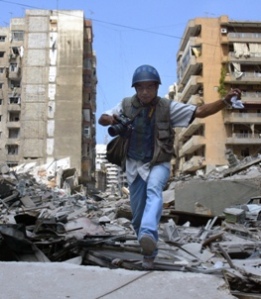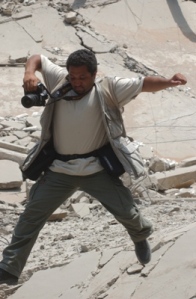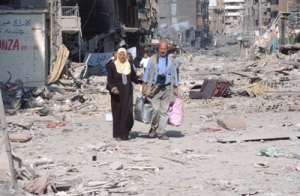
As a child Bilal Kabalan was uncertain about his path in life. His only certainty was that he found pleasure holding a camera. He recalls an incident when he was eight years old involving his first camera. Ever since he could remember he wanted to win a camera from a glass case that housed a random selection of miniature toys.After many attempts and many unwanted toys, finally a small camera dropped out of the glass case. That evening his father took the camera out of Bilal’s hands and intentionally broke it. This unexpected and unpleasant experience did not discourage Bilal from wanting another camera, rather it cemented his desire to not only get another camera but to pursue photography as a career.
During high school Bilal Kabalan studied Physics and was passionately drawn to the specialty of Optics. Day after day as his knowledge of Optics incrased, his love for it deepened. When he was introduced to photography as an adult he found that the similarities between Optics and photography created an easy familiarity between the two fields. Through independent investigation and the influence of two mentors, Rabih el Meghribi and Michel Berzghal, he conscientiously and consistently furthered his career. Being of an inquisitive nature, he never refrained from questioning his mentors in spite of his tendency to be shy and introverted.
Bilal Kabalan is presently a member of the Syndicate of Journalists. He is an adventurous photojournalist, always pushing the edge in pursuit of the perfect photograph. He views every moment of his career as being dangerous. During the civil war between East and West Beirut he was beaten and kidnapped while photographing in his own zone. He recalls a specific incidence in 1978 during the civil war when he and Muhammad Ballout, a fellow photographer, were in Shkif. Bilal had a special fondness for Shkif and made a point of visiting it once a week throughout the years. He felt that it was imperative to observe what was happening in Shkif during the war. He states, “Even during times of peace there is a risk involved in going to Shkif. On this particular day we were shot at and bombs were thrown at us. Rather than fearing for our lives we literally laughed in the face of death and playfully and happily dodged the bullets and fled. Acting like fools, we were incapable of internalizing the gravity of the situation. Based on my experience, I believe it is possible for a photojournalist to lose the ability to internalize information and react appropriately when faced with a life threatening situation.”
Bilal describes his reaction to an encounter with death when he and another colleague went to the region of Zarif to photograph. While in Zarif he saw the bodies of numerous dead people littering the ground. After walking for awhile he noticed one of the bodies holding a camera. Upon closer investigation he realized that the body was his colleague. Bilal took two photographs of his colleague and then proceeded to lend a helping hand, which proved to be of no avail. Bilal went through the motions with no conscious awareness of his actions. Another situation involved stepping on the bodies of the dead while hurrying to take photographs.
Bilal Kabalan asserts that there is no pat answer for whether or not assisting someone in danger takes precedence over taking a photograph. He believes the situation is the determining factor. Fear and terror are his predominant emotions before arrival at the battlefield. Upon arrival all indecision and fear fades away. He claims that “If I even consider retreating from the battlefield and going back home I am convinced that the consequence will be that I will die. I also believe that there are no coincidences. Photographers need to be fully involved in the situation, which means they can’t afford to have even a single thought about ending up a victim.”
Bilal correlates his relationship to his camera with that of a woman, “Sometimes I struggle and fight with my camera because it doesn’t deliver a photograph that meets my expectations. My camera is a human being incarnate, sometimes communicating articulately and at other times not. My camera’s sole job is to meet my standards and expectations. It is advantageous for a photographer to remain single. Oftentimes a wife obstructs her husband’s path to dangerous zones. The camera is my better half, and as such accompanies me where ever I go. Love and hatred are a part of life. I view my life as being filled with love and pleasure.
He holds great admiration for the photographer George Semerdjian. Bilal believes Semerdjian’s photographs provided the foundation for future photojournalists.
In Bilal’s opinion, an excellent and ‘complete’ photograph should emphasize the conceptual aspect of the subject matter rather than simply illustrate shallow and banal beauty. He states, “Every photographer has a unique slant on the subject matter, but personal opinions should not enter into the final product unless it is done intentionally.”
He perceives the photographer as “chasing the changing times” and providing “visual summarizations” of political and social events. He states, “A picture should generalize, not privatize. A photograph actualizes an event by providing a specific time frame and location. This is the reason photographs are more effective at communicating information than news commentators and written articles.”
Bilal Kabalan’s message for youth is that, “Photographs should expose the significant aspects of an incident. Photographs should document the changes of every day life and uncover the hidden realities. A single photo should encapsulate an entire event. The value of a photo is directly related to people’s interaction with it. In Lebanon the increased financial value of photographs is directly related to the increasing need for the work of photojournalists.”
• Name and Surname: Bilal Kabalan
• Place of birth: Mays el Jabal, South Lebanon
• Date of birth: March 2, 1960
• Agency of Employment: “Al Safir” newspaper
• Length of Career: Since 1977
By Sevana Semerdjian





